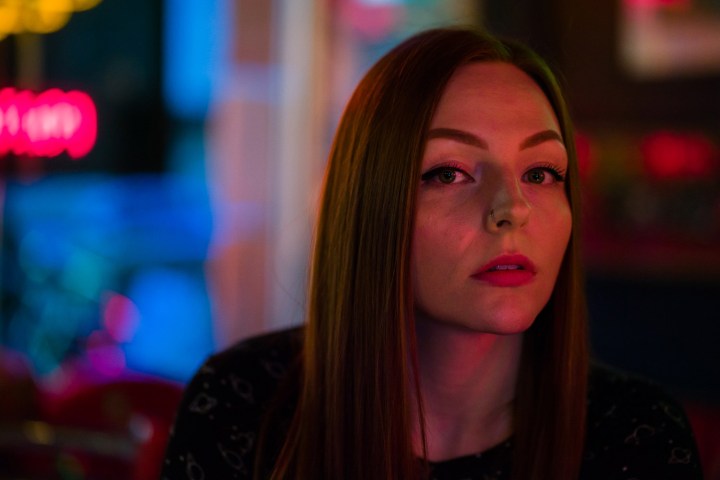
Portrait photography captures a person — great portrait photography captures a personality. While portraits are a staple of the photography industry, they requires much more than simply pointing and shooting. From posing to framing to lighting, several elements must work together to create a good image. With a few simple tips, however, you can get started capturing more than just a pretty face.
Awkward subjects mean awkward smiles
One of the keys to capturing a subject’s personality is helping them feel comfortable in front of the camera. News flash: No one feels comfortable in front of the camera, at least not at first. As the photographer, it’s your job to help the subject relax and feel confident despite having a camera pointed at their face. Don’t just toss out a “say cheese” and expect a genine smile.

First, use casual conversation — silence is awkward. Learn more about your subject and ask what they are interested in, what makes them happy, what irks them. Keep up conversation as you shoot. Avoid a forced smile. Tell stories, ask for their stories or tell jokes to get a genuine smile. Portrait prompts — questions or activities to help the subject relax during the shoot — are helpful for photographers who don’t have that naturally outgoing personality.
Wide-angle lenses tend to be least flattering
Photographers don’t need crazy expensive gear to take great portraits, but that doesn’t mean the gear that you choose doesn’t matter. A camera with a larger sensor — like a mirrorless camera or DSLR — will help create that soft background typically found in portraits, often called bokeh after the Japanese word for blur. The lens, however, is the most important part of the equation.
Wide-angle lenses create distortion and accentuate distance, which will make your subject’s nose look bigger than it really is — and that’s not usually what people want. To fix this, use a lens with a focal length of at least 50mm (in full-frame terms, see our guide to working with crop factor to find the appropriate focal length for smaller-sensor formats), with 85mm and longer lenses even better. You can get a good portrait lens on a budget by skipping the zoom and buying a 50mm or 85mm prime lens.

That’s not to say wide angle lenses don’t have a place in portrait photography. Wider angles are okay for full-body shots and environmental portraits where the background is important to the story. Just try to keep your subject closer to the center of the frame and farther from the camera to reduce the effects of distortion. Other times, the distortion may actually be desirable — such as in concert photography or if you’re going for an edgy or slightly unsettling mood.
Use aperture to exclude — or include — the background.
In many portraits, a blurry background is ideal. This is the result of shallow depth of field, which refers to how much depth in the photograph is in focus (see our depth of field explainer for more information). That’s created by using a wide aperture (longer focal length lenses also help). To get that background blur you want a wide aperture, denoted by a small f-number. Set your camera to aperture priority mode or manual mode and a low f-number, like f/2.8 or lower. Just be careful when working with wide apertures, because getting tack-sharp focus can be challenging.

Also note that not all lenses can open to f/2.8 or wider. Most kit lenses top out at f/3.5 or f/5.6, depending how zoomed-in they are — in this case, just use the widest one available.

In environmental portraits, the background plays a role in the story of the image, such as photographing an artist in her studio or a newborn in his nursery. If you don’t want to blur that background to oblivion, use a narrower aperture (larger f-number). The larger the f-number, the more the background will be in focus. Try an f/5.6 or f/8. When photographing more than one person, you’ll also want to use a higher f-number to keep everyone in focus, unless each person is standing the exact same distance from the camera.
Focus on the eyes
The eyes are key to a good expression, so getting them in sharp focus is key to a good portrait. For best results, set your camera’s autofocus area mode to single point autofocus. This allows you to set the focal point exactly where you want it: On the subject’s eye. Ideally, you should get both eyes in focus, so if the subject’s face is turned towards or away from the camera, you’ll want a bit narrower aperture to get both eyes sharp.

Alternately, if you are using a camera equipped with a good eye-detection autofocus mode, you can simply use this to automatically focus on the eyes.
Find — or create — good light
All the great expressions, camera settings and tack sharp focus can’t make up for bad light. Beginning portrait photographers should look for soft light that’s easy to create great shots with. Full shade on a sunny day or anywhere outside on an overcast day is great light for beginning portrait photographers. An hour before sunset (or after sunrise) with the sun to the side or behind the subject also makes good portrait lighting. It’s slightly trickier to get a proper exposure here compared to full shade, but can be more dramatic. Indoors, across from or adjacent to a window also works well.
While flat, even lighting is the easiest to work with, positioning your subject against a darker background can be a good way to make the portrait pop. A darker background will naturally draw the viewer’s eye to the subject.

As you gain more experience, you’ll learn to create your own light. A simple reflector bouncing back some of that golden hour light is an easy way to get started on manipulating light — or use a diffuser to create your own shade on bright days. From there, you can expand into a diffused on-camera flash on low power to create catchlights that brighten the eyes. Don’t try to jump into advanced lighting too early — start with natural light before moving to more advanced techniques.
Learn posing dos and don’ts
Posing can be an artform itself. But even just getting started, you should know a few basic dos and don’ts to posing to create flattering portrait images. One key concept to remember is that whatever is closest to the camera appears larger. Sounds like a no-brainer, but this is actually an important concept to keep in mind. Unless you are photographing maternity photos, you probably don’t want to shoot from belly-level with a pose that puts your subject’s stomach closest to the camera. Most people may not find that too flattering. Outside of understanding that closest equals largest, here are a few other quick posing essentials even beginners should note:
- Don’t “foreshorten” limbs. If an arm, leg, or fingers are pointed directly towards the camera, that limb will look awkwardly short. It’s a phenomenon known as foreshortening, and is especially common with telephoto lenses (which compress distance, the opposite effect of using a wide-angle).
- Don’t crop at joints. Portraits don’t have to be full body, but when they’re not, make sure you don’t cut people’s arms or legs off at the joints. Cropping at the widest point of the body also isn’t as flattering as cropping where the body narrows.
- Do understand the differences between feminine and masculine poses. While this obviously depends on each individual, men and women typically prefer to be posed in different ways. Feminine poses often create curves with the placement of the arms or position of the body, while masculine poses tend to emphasize straight lines.
- Do give them something to do with their hands. “Where do I put my hands?” is a common question coming from portrait subjects. Help them feel comfortable by giving them directions for their hands. Separating the arms from the torso can help make the subject appear less wide.
- Don’t leave the feet flat. Flat feet creates stiff poses. Ask the subject to shift their weight towards one leg or bend a knee for a more casual stance.
- Don’t assume everyone wants to appear skinny. Standing with the torso at an angle to the camera helps the subject appear thinner. But that’s not ideal for every subject. An athlete, for example, looks powerful and dominant standing straight on to the camera.
Try “action poses” for more genuine results.
Posing is important, but don’t get so caught up in posing that you’re back at the subject feeling stiff and uncomfortable. Action poses can create more natural poses that still flatter. Walking for example, is simple and relaxing. For women, asking them to put one foot directly in front of the other as they walk creates more curves. Jumping is also a good action pose, which can also help people loosen up. Action poses are even better when working with multiple people, like couples or family, because they create interaction.

Portrait photography and capturing someone’s personality can be tough at first. But with some practice, you can create memorable portraits that will leave your subject smiling even after the shutter clicks.



